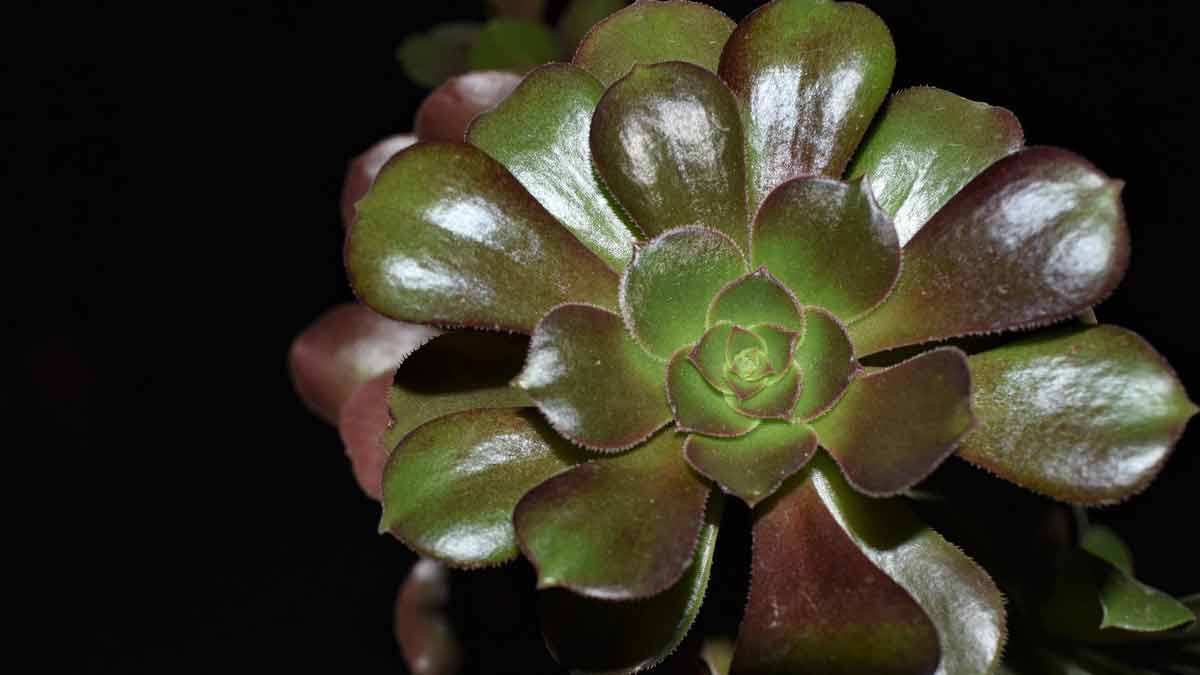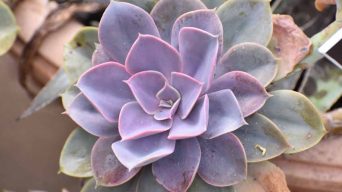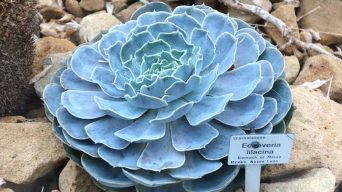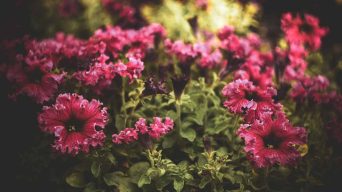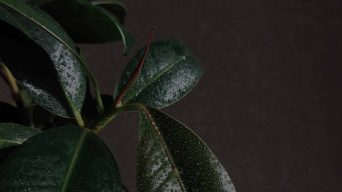Key Takeaways
- Overwatering can cause serious damage to Echeveria plants, leading to root rot and fungal infections that can be fatal if left untreated.
- Signs of overwatering include drooping or yellowing leaves, soft stems, soggy soil, and root rot/fungal infections.
- To treat an overwatered Echeveria plant, stop watering immediately and remove it from the soil. Prune affected leaves and roots before repotting in fresh soil with proper drainage. Adjust your watering schedule and amount while monitoring humidity levels and providing adequate sunlight/airflow to prevent further issues.
- To avoid overwatering in the first place, establish a proper watering schedule based on the specific needs of your Echeveria plant. Use well-draining soil/pots with adequate drainage holes and avoid overcrowding or fertilizing too often.
Echeveria plants are popular among succulent enthusiasts with their unique rosette shapes and vibrant colors.
However, one of the most common issues they face is overwatering, which can lead to root rot and death.
This blog post will discuss the signs of an overwatered Echeveria plant, how to treat it effectively, and tips for preventing it.
Understanding Overwatering In Echeveria Plants
Overwatering in Echeveria plants occurs when the soil is consistently wet and doesn’t allow for proper drainage, leading to root rot and other issues.
Causes Of Overwatering
One common cause of overwatering in Echeveria plants is misunderstanding their water needs.
As succulents, they have adapted to survive in arid environments with infrequent and irregular rainfall patterns.
Consequently, they store water within their leaves, stems, and roots during dry periods.
Another contributing factor to overwatering is improper potting materials or containers that do not allow adequate drainage.
For example, standard potting soil might retain moisture for too long instead of allowing it to drain out quickly, as a fast-draining succulent mix would.
Similarly, using pots without drainage holes or saucers can trap excess water at the bottom of the container leading to overly wet roots and eventual root rot.
How Overwatering Affects Echeveria Plants
Overwatering poses a significant threat to Echeveria plants, as it interrupts their natural water absorption process and creates an environment conducive to bacterial growth and rot.
In nature, these succulents store excess moisture in their thick leaves for later use during droughts or periods of limited water availability.
One common consequence of overwatered succulent plants is root rot – a dangerous condition that spreads toxic pathogens throughout the plant tissue.
This phenomenon occurs when standing water or soggy soil prevents adequate airflow around roots, encouraging fungal infections and the subsequent decay of crucial tissues responsible for nutrient uptake.
Left unchecked, persistent overwatering can cause irreversible damage resulting in stunted growth patterns or loss of vibrant coloration within echeverias’ iconic rosette form.
Signs Of Overwatering Echeveria Plants
If you notice that your Echeveria’s leaves are drooping or turning yellow, its stems are soft and mushy, or its soil is soggy, it may be a sign of overwatering.
Additionally, root rot or fungal infections may also be indications of this issue and should be monitored closely.
1. Drooping Leaves
Drooping leaves can be a disheartening sight for plant owners, especially when dealing with Echeveria, known for their beautiful rosettes and vibrant foliage.
This common sign of overwatering occurs as the excess water causes the cells within the succulent leaves to expand beyond capacity, leading to visible sagging or drooping.
Identifying this issue early on can save your Echeveria from further damage.
For example, if you notice your once rigid and perky leaf edges are now hanging low and wilting away from the center of growth, it’s time to take action against overwatering.
Remember that even though these resilient plants prefer being underwatered rather than drenched with moisture, they still need an optimal environment to thrive and maintain their stunning appearance truly.
2. Yellowing Leaves
Yellowing leaves are one of the most common signs of overwatering in Echeveria plants.
The excess moisture causes the leaves to turn yellow and droop, eventually becoming soft and mushy.
If left untreated, the affected Echeveria leaves may fall off with just a slight touch.
To avoid your Echeveria plants from developing yellowing leaves due to overwatering, it is recommended that you only water them when the soil is completely dry and that their pot has proper drainage.
Hence, they’re not in standing water for long periods.
Additionally, use a well-draining soil mix specifically formulated for succulents or cacti so excess moisture can escape quickly.
3. Soft, Mushy Stems
Soft, mushy stems indicate that your Echeveria plant is being overwatered.
When soil remains wet for too long, it affects the roots and causes them to rot, ultimately weakening the stem and leaves.
This can result in an Echeveria succulent plant that looks wilted or feels squishy when touched.
To prevent soft, mushy stems caused by overwatering, ensure you use well-draining soil with proper drainage holes in your pot.
Also, avoid watering your Echeveria frequently; always wait for the top layer of soil to dry before adding more water.
During winter months, when plants enter the dormancy period, reduce the watering frequency as most succulents do not require much moisture during this time of year.
4. Root Rot Or Fungal Infections
One of the most severe consequences of overwatering your Echeveria plants is the development of root rot or fungal infections.
This occurs when too much moisture in the soil creates a damp environment where harmful bacteria and fungi can grow, attacking your plant’s roots.
If left untreated, root rot and fungal infections can quickly spread throughout your entire plant, leading to its death.
However, if you act fast enough and remove any affected parts early, you can save your Echeveria from destruction.
To treat this problem effectively, removing the infected portions of your plant entirely without damaging healthy areas is essential.
To prevent future incidents of root rot in Echeveria plants, ensure proper drainage by placing rocks at the bottom layer before putting potting mix on top.
5. Soggy Soil
Soggy soil is a common symptom of overwatering Echeveria plants.
It occurs when the roots are constantly exposed to excessive moisture, causing them to rot and lose their ability to absorb nutrients.
When you touch the soil, it feels heavy and damp instead of dry or slightly moist, like healthy succulent soil should feel.
Soggy soil also leads to decreased oxygen levels within the pot, which worsens if left untreated.
This can result in brown spots forming on leaves or stems and root rot, killing your plant in due course.
To prevent soggy soil from affecting your Echeveria plants, ensure they have proper drainage holes at the bottom of their pots so excess water can escape freely.
How To Save Overwatered Echeveria Plants
To save an overwatered Echeveria plant, stop watering and remove it from the soil.
Prune affected leaves and roots before repotting in fresh soil with proper drainage.
Adjust your watering schedule and amount while using additional treatment options, such as adding sand or perlite to the soil.
Stop Watering And Remove From the Soil
The first step to save an overwatered Echeveria plant is to stop watering it and remove it from the soil.
Here’s how to do it:
- Gently loosen the soil around the plant with a garden trowel.
- Carefully lift the plant out of its pot, not damaging its roots.
- Check the roots for signs of rot or fungal infection. If you notice any black or brown roots, use sharp and clean scissors to trim them.
- Remove any excess soil that may be stuck to the roots.
- Let the plant rest and dry out completely before repotting it in fresh soil.
Prune Affected Leaves And Roots
If you notice signs of overwatering on your Echeveria plants, such as drooping or yellowing leaves, soft stems, or soggy soil, it’s important to act quickly to prevent further damage.
One effective solution is to prune Echeveria plants.
Here’s what you need to do:
- Use a clean, sharp pair of scissors or pruners to remove damaged or dead leaves. Cut as close to the stem as possible.
- Inspect the stem for any signs of rotting and cut away any affected areas with the same clean tool.
- Check the roots for signs of rot or fungal infections and trim off any brown or mushy parts using sterilized scissors.
- Once you have pruned all affected areas, allow them to dry thoroughly before replanting.
By pruning affected leaves and roots, you can prevent further damage from occurring and encourage healthy growth in your Echeveria plant.
Always use sterilized tools to avoid introducing additional pests or diseases into the plant.
Repot In Fresh Soil With Proper Drainage
One of the effective ways to save an overwatered Echeveria plant is by repotting it in fresh soil with proper drainage.
Here are the steps to follow:
- Gently remove the plant from its current pot and shake off excess soil.
- Inspect the roots for any signs of rot or damage, trimming them as necessary.
- Choose a new pot that is slightly larger than the current one and has drainage holes at the bottom.
- Fill the new pot with a well-draining potting mix specifically formulated for succulents, or make your own using sand, perlite, and peat moss in equal parts.
- Create a hole in the center of the soil mix and place the Echeveria plant into it, gently spreading out its roots.
- Fill in any gaps with additional soil mix and press down lightly to secure the plant in place.
- Water sparingly and avoid getting water on the leaves or stem until you see new growth.
Remember to adjust your watering schedule appropriately based on environmental factors such as temperature, humidity, and sunlight exposure to prevent overwatering in the future.
Proper drainage prevents root rot and maintains a healthy Echeveria plant.
Adjust the Watering Schedule And Amount
Adjusting your watering schedule and amount is crucial to preventing overwatering in Echeveria plants.
Here’s how:
- Water less frequently: Echeveria plants do not require frequent watering. Instead, allow the soil to dry out completely before watering again.
- Water in smaller amounts: When you water, provide only a small amount at a time.
- Monitor the soil: Use a moisture meter or stick your finger about an inch into the soil to check for moisture levels before watering. If it feels dry, it’s time to water.
Use Additional Treatment Options
If your overwatered Echeveria plants are still struggling after following the previous steps, there are additional treatment options that you can try:
- Use a fan: Place a fan near the plant to improve air circulation and help dry out the soil.
- Apply fungicide: If your plant is suffering from root rot or fungal infections, apply a fungicide according to the package instructions.
- Take stem cuttings: If the upper part of the plant is healthy, take stem cuttings and propagate them to start new plants.
- Use growth hormone: Apply a growth hormone to encourage new root growth on affected plants.
- Provide extra sunlight: Move your Echeveria plant to an area with more direct sunlight to help dry out the soil and prevent further overwatering.
Remember, it’s important not to try all these treatments simultaneously.
Start with one method and monitor your plant’s progress before trying another option.
Your overwatered Echeveria plant can recover and thrive again with patience and care!
Prevention And Maintenance Tips
To avoid overwatering your Echeveria plants, it’s important to establish a watering schedule that suits them.
Also, make sure you use pots and soil that drain well, keep an eye on humidity levels, provide them with enough sunlight and air, and avoid overcrowding and excessive fertilization.
Establish A Proper Watering Schedule
Keeping a consistent watering schedule is key to the health and longevity of your Echeveria plants.
It’s important to avoid overwatering, as too much moisture can lead to root rot and other fungal infections.
Make sure to water only when the soil is dry, typically every 7-14 days, depending on humidity levels and temperature.
You may need to water more frequently in the summer months due to higher temperatures.
To ensure proper drainage, use well-draining soil mixes with added perlite or sand for extra airflow around the roots, and make sure pots have drainage holes in the bottom.
Additionally, try not to get water directly onto any leaves or stem of your Echeveria plants during watering sessions – this can lead to mold growth or sun damage if left unaddressed.
Use Well-draining Soil And Pots
Using well-draining soil and pots for your Echeveria plants is crucial to prevent overwatering and root rot.
Sandy potting mixes are ideal for succulents like Echeveria because they allow excess water to drain away easily, preventing the soil from becoming too wet.
Without proper drainage, your Echeveria plant’s roots will be constantly exposed to moist soil, which can lead to root rot.
This disease attacks the roots of plants and can quickly spread throughout your plant if left unchecked.
Monitor Humidity Levels
Humidity levels are crucial in Echeveria plants’ overall health and well-being.
These species thrive in dry environments, but that doesn’t mean they can do it entirely without moisture.
If the environment is too humid, it can lead to excess moisture in the soil and increase the risk of overwatering.
On the other hand, too dry can cause your Echeveria leaves to curl up or even fall off.
Maintaining a balance between these extremes is vital by monitoring temperature changes and seeking ways to regulate air circulation around your plants.
Provide Adequate Sunlight And Airflow
Providing adequate sunlight and airflow is important to keep your Echeveria plants healthy and thriving.
These succulents are native to arid regions and require plenty of bright light for optimal growth.
However, too much direct sun exposure can scorch their delicate leaves.
Additionally, proper ventilation helps prevent issues such as high humidity and powdery mildew.
To increase airflow around your Echeveria plants, make sure they are not overcrowded or tightly packed in their pots.
You can also use a fan or dehumidifier to promote air circulation in the area where they are kept.
Avoid Overcrowding
When it comes to Echeveria plants, overcrowding can be a serious issue. When too many plants are crammed into one pot, the roots can tangle and struggle to grow properly.
This can lead to stunted growth and poor overall health for your Echeverias.
Additionally, if you notice your Echeveria leaves beginning to droop or turn yellow even when you’re following proper watering practices, it might be time to check if they’re becoming overcrowded.
Overcrowding can also provide an ideal environment for pests like mealybugs to quickly spread from plant to plant.
Avoid Overfertilizing
Overfertilizing Echeveria plants can be just as detrimental as overwatering them.
These plants do not require frequent fertilizing, and an excess of nutrients can damage their roots and foliage.
To maintain healthy Echeveria plants, use a balanced fertilizer in moderation during the growing season (typically from spring to fall).
Be sure to dilute it properly before applying it to your soil mix.
Additionally, opt for slow-release fertilizers that are gentle on succulent roots or organic alternatives like compost tea.
Final Thoughts
Overwatering can be detrimental to Echeveria plants, leading to root rot and ultimately killing the plant.
It’s essential to identify the signs of overwatering, such as mushy leaves and wilting, before it’s too late.
To treat an overwatered Echeveria, remove it from its pot, allow the soil to dry completely, prune affected roots and leaves, repot with fresh soil with proper drainage, and adjust the watering schedule and amount accordingly.
Prevention is key to establishing a proper watering schedule, using well-draining soil/pots, monitoring humidity levels, and providing adequate sunlight and airflow while avoiding overcrowding and overfertilizing.

